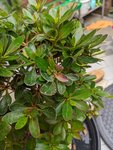I think it is an overall effect. Azalea have shallow fine roots. Sitting in full sun at peak day causes the roots to become hotter. Even more so in a bonsai, even though you would water more often. In a garden, the soil will dry out and it may not get watered. So while more sun and higher temperatures may mean it can theoretically grow faster, not enough water will offset this a lot more.
The burns on the leaves you see, I am not sure if they are a drought effect that could be mitigated by wetter roots, or a direct effect of the sun on the leaves regardless of how much water the plant has. My best-looking azalea plants actually grow on the north facing part of the garden. Yes, they grow less quickly, but the compact growth actually makes them more attractive to look at. And leaves seem to stay on the plant for a longer period of time. I even have one plant that is in the full shade and I cannot really see it most of the time because it is behind other plants. And it grows and flowers fine.
So I cannot actually answer your question satisfactory. Whatever physiological mechanism dominates this, I am not sure.
But, I was recently watching this video:
And the bonsai artist actually says he puts all his repotted satsuki in full sun (Japanese summer humidity). I think his explanation about that it kills bad bacteria is complete nonsense. But it will warm up the soil and the roots and increase the rate of metabolism there.
The optimum is usually recommended as 'morning sun, afternoon partial shade' for garden plants. With bonsai you have all kinds of techniques and tricks you can use. If all too much sun does it dry out the plant, adding water can completely cancel out the negative effect of full sun.
I worked at a department where they studied how plants adapt to the change in light intensity during the day. And plants employ all kinds of strategies to protect their light-harvesting complexes and other pigment molecules that absorb energy and get excited, from too much sunlight. I don't remember the details, but if you know that plants have evolved over about 500 million years, you can imagine all kinds of tricks evolved. But during full sun middle day, I think that azalea would be among the plants that are protecting themselves from most of the light, rather than harvesting as much of it. It turns out the sun is actually really powerful and putting out a lot of watts per square meter. And plants are not very efficient, and don't need to be, in harvesting all that energy. But they also don't want any free radicals or too much heat or too much loss of water. Some azaleas evolved to live in the niche of a sun-exposed mountain face with a thin layer of soil. Your satsuki is not exactly such a plant, but a related species.
Besides that, uv light destroys colour pigments in flowers, causing them to fade. This is especially true in red flowers (as you can imagine that purple/violet flowers have pigments that reflect a lot of purple/near-uv visible light, while red flowers absorb all of it, making them more red). We all know sunlight will cause colours to fade. But this can happen in a sun-exposed red flower in days. But, glass from a greenhouse should lessen that effect as glass is opague to the more energetic uv light.













